Tag: EOS 7D Mark II, Continuous Shooting, Drive mode, Mirror vibration control
EOS 7D Mark II is the first EOS DSLR camera with a APS-C sized image sensor to achieve stunning 10 frames per second high speed continuous shooting. To achieve high speed continuous shooting, increasing the speed of the mechanical parts only is not an answer; the stability of the AI Servo AF during continuous shooting must also be taken into consideration. The EOS 7D Mark II thus adopted a series of new designs to achieve 10FPS high speed continuous shooting, AF stability, shortened shutter release time lag and higher reliability.
10FPS high speed continuous shooting
As in EOS-1D X, EOS 7D Mark II employs a two-motor system with high torque motors dedicated to mirror drive and shutter cocking respectively. In particular, the shutter cocking motor uses a highly efficient coil system that reduces the peak current by 30% when comparing to EOS 7D, which reduces the charge time. In combination with ball bearings with good energy transmission rate and short-distance gear train (2 fewer gears than EOS 7D), shutter cocking time is shortened. The shutter unit itself incorporates a total of 4 ball bearings (in contrast to 1 in EOS 7D) to improved energy transmission efficiency and durability. This new mirror and shutter mechanism successfully realizes the 10FPS high speed continuous shooting.
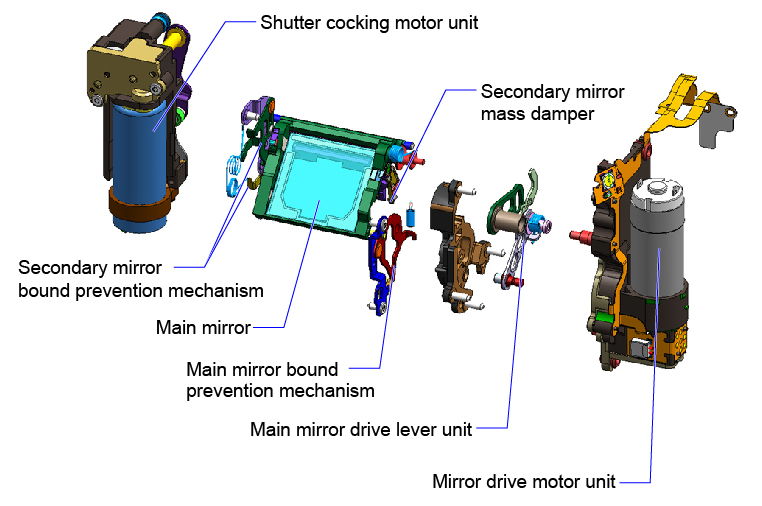
Two-motor system in EOS 7D Mark II

Shutter unit incorporated 4 ball bearings
Auto focus and mirror vibration control
During high speed continuous shooting, AI Servo AF focuses at the moment when the mirror is down. The main mirror and secondary mirror must stay still during focus to ensure high precision of AI Servo AF. The EOS 7D Mark II incorporated a number of technologies to ensure the bouncing during the mirror’s up and down action is absorbed in a short time. This enables high precision AI Servo AF and a stable viewfinder image during 10FPS high speed continuous shooting.
Mirror Vibration Control
Technologies to control mirror vibration
1. In contrast to EOS 7D’s spring-based mechanism, the EOS 7D Mark II directly controls the mirror‘s up and down movement with a motor, making it possible to slow down the mirror’s movement right before it hits the mirror box wall inside the mirror unit to reduce impact.

Conceptual diagram of mirror-drive mechanism
2. Both the main and secondary mirror use a bound prevention mechanism to absorb the bound instantaneously.
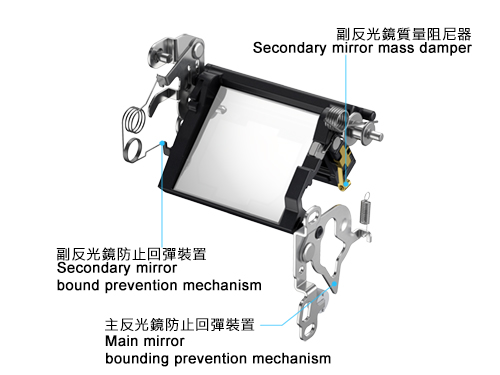
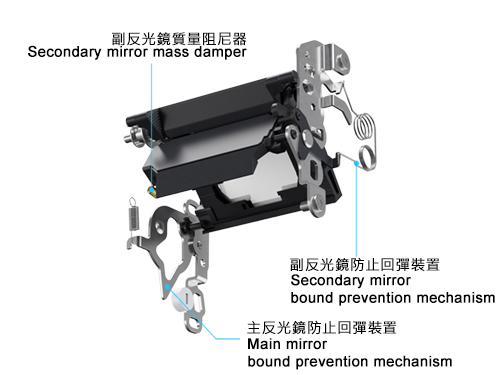
Main mirror and secondary mirror bound prevention mechanism and mass damper
3. When the mirror is down, a mass damper applies a force opposite of the secondary mirror’s bound direction to reduce the bound
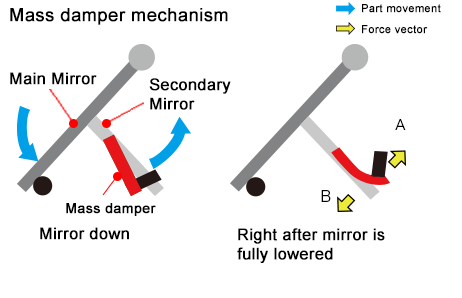
Right after the mirror is fully lowered, the impact hits the secondary mirror, causing force in direction B. But the spring’s elasticity forces the mass damper’s weight in direction A. By generating opposite force and offsetting kinetic energy, this action reduces vibration.
Shortened shutter release lag
With a number of mirror vibration control technologies, the mirror bounce time of EOS 7D Mark II has been shortened. Apart from more precise auto focus, the shutter release time lag has also been reduced successfully to 55ms, comparable to that of EOS-1D X. The reduction of impact when the mirror is raised or lowered also helps reducing image blur and operational noise while enhancing durability.
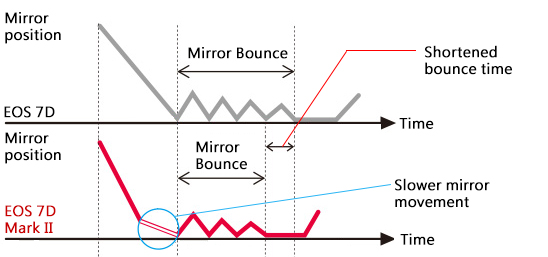
Conceptual diagram of EOS 7D Mark II mirror bounce control

